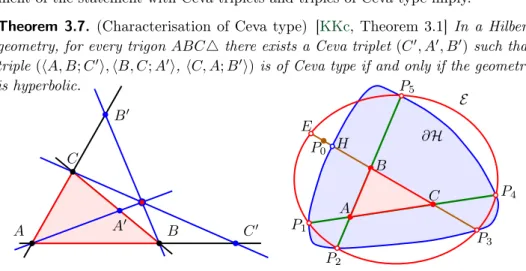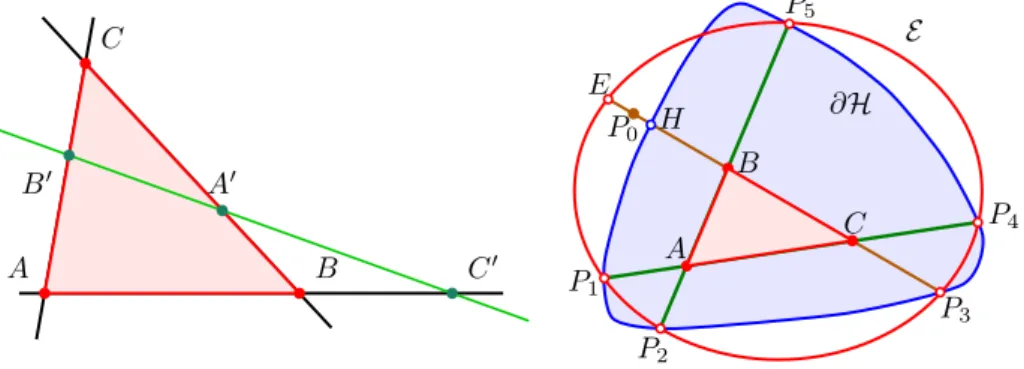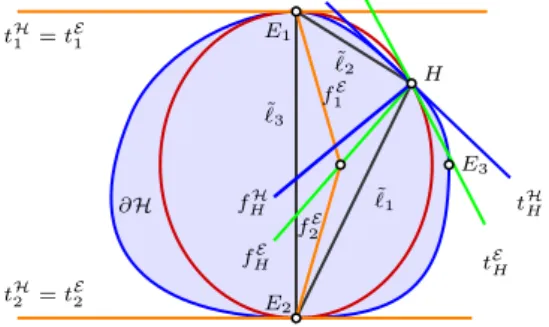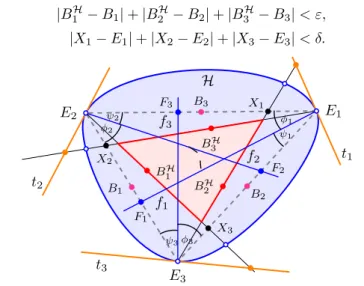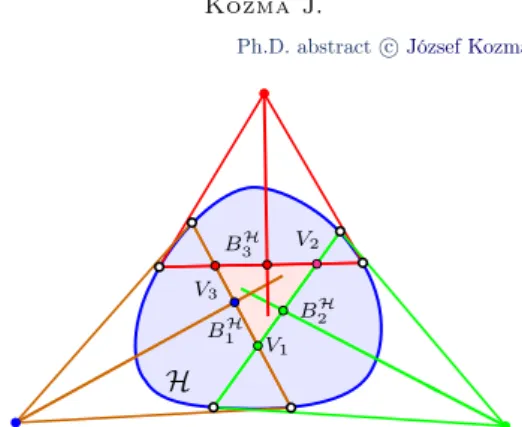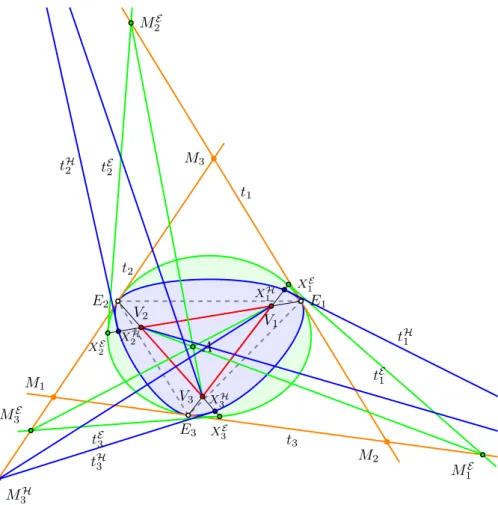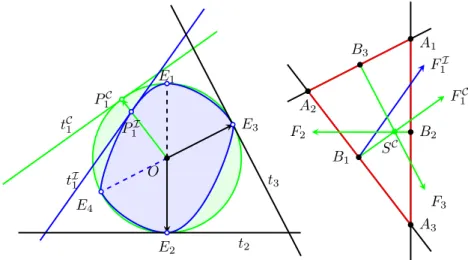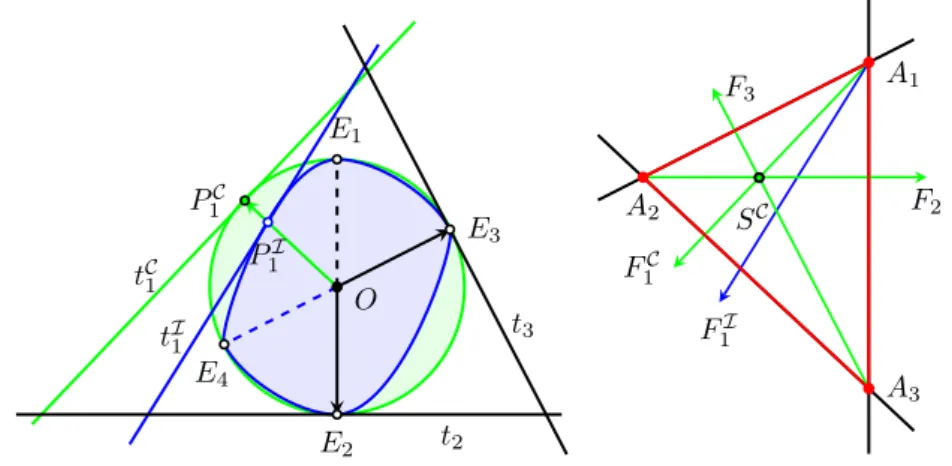Doctoral School in Mathematics and Computer Science University of Szeged, Bolyai Institute
Characterisation of geometries in projective-metric spaces
Ph.D. abstract
József Kozma
University of Szeged, Bolyai Institute
Supervisor:
dr. habil Árpád Kurusa
1 Antecedents
At the Second International Congress of Mathematicians (1900) David Hilbert raised a range of decisive problems for the mathematics of the 20th century. Fourth in the row was the identification of those geometries, emerging as common generalisation of classical non-Euclidean geometries, the straight line in which possesses the"shortest path" property.
Starting with the works of his students, P. Funk [6] and G. Hamel [8], thanks to the work of many other mathematicians, such as W. Blaschke [2], A. V. Pogolerov [18]
and Zoltán Szabó [19], we are able to produce all the “projective-metric” geometries.
These are far too many to investigate one by one, however, Busemann pointed out [4] that two most important type of them can be separated, the Minkowski and the Hilbert type, as isometries of straight lines in these two cases are projectivities (namely affinities, in case of Minkowski geometry).
Minkowski geometries can be known more thoroughly, since a significant deal of mathematicians knows them normed vector spaces, and a rather rich literature musters their properties and characteristics [1,20], for example, that a Minkowski plane is Euclidean if and only iffor any vectorsxandyof the unit circle,(x+y)⊥b
(x−y), where indexB refers to Birkhoff perpendicularity [10].
Hilbert geometries are less familiar1, however, their researches fall into line with new and diverse results time and again [17].
By way of example, hyperbolic geometry is characterised among Hilbert ge- ometries by any of the following statements:
◦ perpendicularity is symmetric; in higher dimensions, as well [11], [3];
◦ the metric is locally Euclidean [10];
◦ there exists axial reflection in every straight line [3];
◦ curvature is non-positive in all points of the geometry [15];
◦ area of asymptotic triangles is constant in the geometry [5].
The aim of our research was to extend these results with characterisations, where geometric configurations do the lead.
2 Methods and knowledges applied
We apply in the theses, therefore present,Minkowski geometries (which are general- isations of the Euclidean geometry), themetric ratio andBrkhoff perpendicularity.
We apply and present, as well, Hilbert geometries and thehyperbolic ratio, further- more, properties of some fundamental configurations of hyperbolic geometry.
1Elsősorban ezért mutatjuk be a Hilbert-geometriákat kicsit részletesebben.
Beyond these, apply and introduce the notion ofbundles; the notion of bi- sectoral centre and orthocentre in triangles; furthermore the notion ofMenelaus, respectively Ceva triplets of points and real numbers.
As they are not generally known in hyperbolic case, however we utilise them, proofs will be given for the following theorems, in the well known Cayley–Klein, respectively Poincaré modell.
Theorem 2.1.(Hyperbolic Menelaus’ theorem[16, p. 467–468]) A triplet(C0, A0, B0) of the trigonABC4 in the hyperbolic space is of Menelaus type if and only if the triple (hA, B;C0i,hB, C;A0i,hC, A;B0i) is of Menelaus type.
Theorem 2.2. (Hyperbolic Ceva’s theorem [16, p. 467–468]) A triplet (C0, A0, B0) of the trigon ABC4in the hyperbolic space is of Ceva type if and only if the triple (hA, B;C0i,hB, C;A0i,hC, A;B0i)is of Ceva type.
Theorem 2.3.(Theorem on hyperbolic bisectoral centre [16, p. 350]) In hyperbolic space, perpendicular bisectors of every trigon belong to a bundle.
Theorem 2.4.(Theorem on hyperbolic orthocentre [9, Theorem 3]) In hyperbolic space, altitudes of every trigon belong to a bundle.
In the course of presenting the most important characteristics ofHilbert ge- ometries, we show about the logarithm of the cross ratio that fulfils the triangle inequality, and in fact determines a metric in the defining domain. We point out that a local Minkowski metric arises from the metric at each point, and the Hilbert geometry is a Finsler manifold with this metric. Perpendicularity is defined via this metric, which is in accordance with the Birkhoff perpendicularity. We show that a line is perpendicular to an another one exactly when the latter one is concurrent to the tangents taken at the endpoints. Observe that every collineation, keeping the base domain invariant, is an isometry of the Hilbert geometry, furthermore,each isometry of the Hilbert geometry is a restriction of some collineation of the projective
plane on the base domain, keeping the base domain invariant (see [3, (22.10)]).
3 Exposition of the main results
Main results presented in the theses have been appeared in three publications [KKc,KKh,Km], in addition, we refer to a joint publication [KKp], furthermore some other results [KKq]. These all, without exception, give characterisations of classical Euclidean, respectively hyperbolic geometry among Minkowski, respectivey Hilbert geometries.
The first technical result in the course of the preliminaries gives the strict monotony of the hyperbolic ratio.
Lemma 3.1. [KKc, Lemma 2.3]LetA, B and C be collinear points in the Hilbert geometry given byH, and letAB∩∂H={P, Q} such that Ais between P andB.
Consider a Euclidean coordinate system of the lineAB such that the coordinate of P is0, and the coordinate ofAis1. Let the coordinates of the pointsQ,BandCbe q,band cwith the assumptions q > b >1and0< c < q. Then, for the hyperbolic ratio we have
hA, B;Ci= c−b (c−1)√
b s
1 + b−1 q−b.
Use of cross ratio makes possible the unified projective discussion of the clas- sical Ceva’s and Menelaus’ theorems (see [KKp, 2.2. tétel]). For this end, original Ceva configuration is supplemented with straight lines and points in the projective plane, obtained by extension of the affine plane (see Figure3.1).
Theorem 3.2.([KKp, 2.2. Tétel]) LetfA,fB andfC be straight lines through the corresponding vertices of the trigon ABC4, and letX,Y andZ be points one by one on the sides of the trigon ABC4. Let the points A0,B0 andC0 be one by one the intersections of linesfA,fB andfC with the straight lines of the opposite sides.
(1) IffA,fB andfC are concurrent, and pointsX,Y and Z are collinear, then
(A, B;C0, Z)(B, C;A0, X)(C, A;B0, Y) =−1. (3.1)
(2) If (3.1) fulfils, then points X, Y, Z are collinear if and only if straight lines fA, fB andfC are concurrent.
Z Y X
A
B
C A0
B0 C0
Figure 3.1.Projektív Ceva-konfiguráció
The theorems which characterise the Euclidean, respectively hyperbolic ge- ometries among Minkowski, respectively Hilbert geometries, were obtained via com- paring smooth curves with ellipses. In the course of this,John–Löwner ellipses of strictly convex domains have a prominent role, hence we review the basic statements regarding tangent points of circumscribed John–Löwner ellipses (of minimum area),
and prove two lemmas about position of these tangent points, respectively triangles they determine. Particular statements of the following lemmas are applied in the later proofs.
Lemma 3.3. ([KKc] Lemma 2.2) For any non-empty, open, convexH set in the plane, which is not an ellipse, there is an ellipseE containingH such that the set
∂E \ H has at least six different points, and the setE \ H is not empty.
Lemma 3.4.([KKh, Lemma 3.3]) LetHbe a convex domain in the plane. Then (1) there exists a circumscribed ellipse nEofHwith at least three different tangent
pointsE1, E2, E3 in the set∂H ∩∂E such that the closed triangleE1E2E34 contains the centreC of the ellipseE, and
(2) ifH 6≡ E, then these tangent points can be chosen such that in all neighbour- hood of one of them condition∂H \∂E 6=∅fulfils.
Lett1, t2 andt3 be the common tangents of the two shapes at points E1, E2, and E3, respectively. Then
(3) if triangleE1E2E34contains pointC internally, thent1, t2, t3 form a trigon, with verticesM1=t2∩t3,M2=t3∩t1 andM3=t1∩t2such that this trigon contains ellipseE internally, excepts points E1, E2, E3;
(4) if some side of triangleE1E2E34 containsC, sayC∈E2E3, then the three tangents determine such a half strip in the plane between parallel lines, vertices (possibly ideal ones) of which areM2=t1∩t3,M3=t2∩t1, ant this contains internally ellipseE, except tangent pointsE1, E2, E3.
IfB1, B2, B3 one by one are midpoints of segmentsE2E3,E3E1 andE1E2, then (5) linesMiBi (i= 1,2,3) meet in the pointC.
In the course of the proof of our theorems we have to compare smooth, convex curves in the plane that have common tangent and sign of curvature at a point, and one is in the interior of the other. These results were obtained applying the usual apparatus of differential geometry [13].
Lemma 3.5.([KKh, Lemma 3.4]) Letr,p: (−ε, ε)→R2 be twofold continuously differentiable curves for small values ε >0such that p(τ) =p(τ)uτ, and r(τ) = r(τ)uτ, wherep, r: (−ε, ε)→R+, furthermore,r(τ)/p(τ)takes the minimum value 1 exclusively atτ= 0.
Then tangent lines of the curvesr, respectivelypat the pointsr(τ), respectively p(τ)meet each other in a pointm(τ)which tends to the pointp(0)asτ →0, namely such that this point is on the same side of the straight lineOp(τ)asp(0).
Lemma 3.6. ([Km, Lemma 2.4]) Let r,p: [0; 1]→ R2 continuously differentiable curves with non-vanishing derivative.
(1) If (i)rkp,(ii)r˙ kp, and these curves meet each other, then˙ r=p.
(2) If r(0)˙ kp(0), and˙ r(1)˙ kp(1), there there exists a value˙ t0∈(0,1)such that
˙
r(t0)kp(t˙ 0).
3.1 Characterisation of hyperbolic geometry among Hilbert geometries
The question was the following: what consequences in Hilbert geometry the fulfil- ment of the statement with Ceva triplets and triples of Ceva type imply.
Theorem 3.7. (Characterisation of Ceva type) [KKc, Theorem 3.1] In a Hilbert geometry, for every trigon ABC4 there exists a Ceva triplet(C0, A0, B0)such that triple(hA, B;C0i,hB, C;A0i,hC, A;B0i)is of Ceva type if and only if the geometry is hyperbolic.
∂H E E
P0 H
P2
P3
P1
P4
P5
C B
A
A B
C
A0 B0
C0
Figure 3.2.Ceva configuration and a triangle for the counterexample
According to the opportunity provided by [7, Lemma 12.1, p. 226], in the course of the proof, we can restrict ourselves to the plane. The key of the proof is to taking six points on the curve defining the Hilbert geometry by use of Lemma3.3 regarding John–Löwner ellipse such that — under the indirect assumption of∂H being not an ellipse — five out of them are on an ellipse while the sixth is an internal point of it. With a proper pairing we get a non-degenerate triangle such that two sides belong to straight lines which are hyperbolic and of Hilbert type at the same time, while the hyperbolic straight line of the third side includes that of Hilbert type (see Figure3.2). According to Lemma 3.1, hyperbolic ratios on the first two lines are equal while different on the third one. Therefore, to a Ceva triplet, according to the hyperbolic Ceva’s theorem, belongs a triple of Ceva type with +1 as a product of ratios, while the product of the ratios according to the Hilbert geoemtry can not be+1, hence the triple of numbers cannot be of Ceva type in the Hilbert geometry.
The characterisation property of the Menelaus’ theorem follows analogously.
Theorem 3.8.(Characterisation of Menelaus type) [KKc, Theorem 3.2]In a Hilbert geometry, for every trigon ABC4there exists a Menelaus triplet (C0, A0, B0)such that triple(hA, B;C0i,hB, C;A0i,hC, A;B0i) is of Menelaus type if and only if the geometry is hyperbolic.
∂H E E
P0 H
P2
P3 P1
P4
P5
C B
A B A
C
A0 B0
C0
Figure 3.3.Meelaus configuration and a triangle for the counterexample
Recall that similar problem for Minkowski geometries is not brought up as a matter of fact, since the metric ratio and the affine ration are identical in such a geometry, therefore Ceva’s and Menelaus’ theorems fulfil exactly the same way as in the Euclidean geometry.
The next step is the investigation of the natural question: Is it possible a similar characterisation with perpendicular bisectors, respectively altitudes?
Before formulate the answer we have to mention that in the case of Hilbert geometries the inverse of the Hilbert perpendicularity, theH-perpendicularity, is used for the perpendicular bisectors and later for the atitudes, as well, because we could not get any result in the case of Birkhoff perpendicularity, and we could not find a similar result in the literature, neither.
While perpendicular bisectors of a trigon incident to the centre of the circum- circle in the Euclidean geometry, a trigon in the hyperbolic plane does not have a circumcircle generally — however, the perpendicular bisectors of the sides of a trigon form a bundle the same way, hence one can speak of existence ofbisectoral centre. The situation is the same in the case of the altitudes — they form a pencil both in Eucliden and hyperbolic geometry, hence one can speak oforthocentre this case (Theorem2.4).
The natural question arises: Under what conditions is the bundle property fulfilled? And if so, what can be stated about the geometry?
We arrived an answer through two theorems which are interesting on their own, as well.
Let us mention first one of our results on ellipse characterisation. This is a geometric characterisation2of ellipses built on harmonic divide, and applies to the following configuration.
Configuration 3.9. For different pointsEi (i= 1,2,3) on the oval ∂H denote`i
the linesEjEk (i, j, k are different), and tHi the tangents toHthrough pointsEi. Finally, denotefiH the line, that is divided harmonically from the linetHi by the lines`j=EkEiand `k=EiEj (j, k= 1,2,3).
N
E1
E2
E3
∂H
`2
`3 `1
tH1
tH2 tH3
f2H f3H f1H
Figure 3.4.Configuration for the ellipse characterisation
Theorem 3.10. [KKh, Theorem 4.2] Let us consider a Configuration3.9.
(i) If His an ellipse then the straight linesf1H, f2H, f3H are concurrent.
(ii) If f1H, f2H, f3H are straight lines in a bundle for an arbitrary chose of points E1, E2, E3∈∂H, thenHis an ellipse.
The proof of part (i) can be read off from the Figure3.5.
∂E
`2
`1
`3
$(`2) $(`1)
$(`3)
tE1
tE3
tE2 f1E
f2E
f3E f1D
f2D f3D
∂D
tD1 tD3
tD2
$ E1
E2
E3
$(E1)
$(E2)
$(E3)
Figure 3.5.$ transforms the ellipseE into discD, the triangleE1E2E34 into a regular one.
2It turned out later that its dual — via Ceva’s and Menelaus’ theorems — is equivalent to a former result of Segre, concerning finite geometries.
In order to prove (ii), transform the configuration so that two out of the three chosen points be diametrical, with tangents lines perpendicular to their position vectors. Then take an ellipse that has common tangents with the curve at these points, and the third chosen point is common, as well (see Figure3.6).
∂EH
∂H
`˜2
`˜3
˜`1 tH1 =tE1
tH2 =tE2
tEH tHH fHE
fHH f1E
f2E E1
E2
E3
H
Figure 3.6.Introducing harmonic bundle through a point
Now we prove that the tangent is common at the third point, as well, finally show that our curve is an ellipse with centre in the origin.
Our second important result is a theorem of Ceva type on triangles inscribed an oval, which is proven for the extended Configuration3.9of the Configuration (3.11).
`3
`1 `2
`03
`01
`02
σ30
σ01 σ02
t1 t2
t3
ξ1
α1 β1
ξ3
α3
β3 ξ2
α2 β2
E1
E2
E3
X1
X2
X3
X1H
XH2
X3H
X1t
X2t
X3t V1
V2
V3
H
Figure 3.7.Extended Configuration3.9
Configuration 3.11. Configuration3.9is extended as follows.
Let pointXi be close to the pointEi on the open segmentσi=EjEk for all i= 1,2,3, where{j, k}={1,2,3} \ {i}, and denote straight linesE2X3,E3X1and E1X2one by one`01, `02and`03.
Ph.D. abstract cJózsef Kozma(2018. January 10.)
Take the following pointsV1=`02∩`03,V2=`03∩`01,V3=`01∩`02of intersections.
Let us introduce the notationsσ10 =V2V3, σ20 =V3V1and σ30 =V1V2 for the open segments determined by these points of intersections. Furthermore, let us take the points of intersection X1t =t1∩`03, X2t = t2∩`01,X3t = t3∩`02, respectively X1H =∂H ∩(`02\ {E3}),X2H =∂H ∩(`03\ {E1}),X3H =∂H ∩(`01\ {E2})on the tangent lines, respectively on the curve∂H. These points of intersections come into existence when pointsXi are chosen sufficiently close to points Ei (i= 1,2,3).
Finally, let the magnitude of the anglesX2E1E2∠, X3E2E3∠,X1E3E1∠be one by oneξ1,ξ2,ξ3, while that of angles X1tE1E2∠,X2tE2E3∠, X3tE3E1∠be one by oneα1,α2, α3, and that of the anglesE3E1E2∠, E1E2E3∠,E2E3E1∠be one by oneβ1,β2,β3.
N Theorem 3.12. [KKh, Theorem 4.4] Consider a Configuration3.11. For eachi= 1,2,3denoteBi the Euclidean midpoint of the segmentσi, andBiH theH-midpoint of the open segmentσi0. The straight linesf1, f2, f3 belong to one bundle if and only if the points X1,X2 ésX3 can be chosen for anyε, δ >0 such that
|B1H−B1|+|B2H−B2|+|BH3 −B3|< ε,
|X1−E1|+|X2−E2|+|X3−E3|< δ.
t1
t2
t3
f1
f2
f3 φ1
ψ1
φ3
ψ3
φ2
ψ2 E1
E2
E3
X1
X2
X3
F1
F2
F3
B1 B2
B3
B1H B2H
B3H
H
Figure 3.8.Construction with the midpoints
Calculations necessary for the proof of the theorem can be carried out applying cross ratios figured out by means of angles and lengths indicated on Figure3.8.
The answer for the question, regarding the bisectoral centre, in the case of Hilbert geometry is given by the following theorem.
Theorem 3.13.([KKh, Theorem 5.1]) Every triangle has a bisectoral centre in a Hilbert geometry if and only if the geometry is hyperbolic.
H
B1H BH3
BH2 V1
V2
V3
Figure 3.9.Perpendicular bisectors of a trigon in Hilbert geometry
The indirect assumption in the proof of the theorem is that domainHdetermin- ing the geometry is not an ellipsoid. With respect to the statement [3, Lemma 12.1, p. 226] it is enough to work in the plane. According to part (1) of Lemma3.4, there exists an ellipseE of minimum area, circumscribedH, with at lest three different tangent pointsE1, E2, E3in∂H ∩∂E, and with the property that the closed trigon E1E2E34contains the origin . Hence one can consider the configuration described in part (4) of Lemma3.4, which can be obtained by a projection given in part (3) of the same lemma. Given the necessary points and lines we can apply Lemma3.1, then for the points of intersection with verified existence, proceeding by Lemma3.5 obtain a configuration such that Theorem3.10and Theorem3.12guarantee appro- priate convergence for midpoints of Euclidean, respectively Hilbert type. Finally we arrive at the existence of a trigon for which the intersection of certain halfplanes of its perpendicilar bisectors is empty, while one can construct a point which is in all the three halfplanes. This is a contradiction with the starting assumption.
As we had seen the characterising property of the existence of bisectoral centre via the investigation of perpendicular bisectors, we have expected, and actually obtained similar result for the altitudes.
H
V1 V2 V3
Figure 3.10.Altitudes of trigons in Hilbert geometry
Characterisation of geometries in projective-metric spaces
Theorem 3.14.([KKh, Theorem 5.2]) If every triangle has a bisectoral centre in a Hilbert geometry, then it is hyperbolic.
t1
t2
t3
tE1 tH1 tE2
tH2
tE3 tH3
E1
E2
E3 X2E X2H
X1E X1H
X3E X3H
M1
M2 M3
V1
V2
V3
M1E
M1H M2E
M3E
M3H
A
Figure 3.11.Triangle with altitudes intersecting internally
We arrive a contradiction assuming thatH is not an ellipse, considering a construction similar to the one employed in the previous theorem (see Figure3.11).
With regard to the previously referred lemmas it is enough to prove in two dimen- sions, moreover, we can restrict the proof to a suitable configuration. The Euclidean points of intersections, obtained in the respective steps, lead to a point that should be in the intersection of three given halfplanes of perpendicular bisectors of Hilbert type; however this intersection is demonstrably empty.
3.2 Characterisation of Euclidean geometry among Minkowski geometries Thereafter, we looked for theorems in Minkowski geometries analogous to theorems regarding bisectoral centre and orthocentre in Hilbert geoemtries. This time we came at results in the case of Birkhoff perpendicularity and its inverse, i.e. for left-, respectively right-perpendicularity, as well.
Let us start with the problem of bisectoral centre. We prove first that right- perpendicular perpendicular bisectors pass trough one point (the right bisectoral centre) for every triangle if and only if the geometry is Euclidean. Next we also show that right-perpendicular altitudes pass trough one point (right orthocentre) in a Minkowski geometry exactly when it is Euclidean.
Theorem 3.15. ([Km, Theorem 3.1]) The right-perpendicular bisectors are concur- rent fo every triangle in a Minkowski geometry if and only if it is Euclidean.
According to [3, Lemma 12.1, p. 226.], it is enough to prove in the plane.
Our indirect assumption is that the indicatrix has a two dimensional section which is not an ellipse. By Lemma 3.4 there exist three different points in the intersection of the ellipse and the indicatrix. With respect to the central symmetry, the intersections of the two curves appear in pairs symmetric to the centre, hence we have at least four different points. We arrive at a contradictions in specific cases according to the number and the position of the pairs of points (perpendicularity of their straight lines), via investigating a properly constructed trigon (for a specific case see Figure3.12).
tC1
t2
t3
tI1
O E1
E2
E3
E4
P1C P1I
M1
M2C M3C
M2I M3I
B1C B1I
B2C B2I B3C
B3I
SC SI
Figure 3.12.Right-perpendicular bisectors whenSC6=P1C
Ph.D. abstract cJózsef Kozma(2018. January 10.)
In course of the proof we apply the previously proven Lemma3.6, which shows that two perpendicular bisectors of a trigon meet the third one in points on opposite rays with common starting point.
The concurency of right-altitudes is a characterising property, as well.
Theorem 3.16. ([Km, Theorem 3.2]) The right-altitudes are concurrent for every triangle in a Minkowski geometry if and only if it is Euclidean.
The proof restrict the procedure to a suitable two dimensional configuration based on the first two out of the 11 main steps of the proof of the previous theorem.
Then proceed with dividing the demonstration to cases corresponding the number of common points of the indicatrix and the John–Löwner ellipse, respectively the position of the pairs of common points.
We show also this time that two altitudes out of three of a trigon meet the third one in different points. For this end investigate the angle of the indicatrix and the ellipse. As a consequence of Lemma3.5, the comparison of the altitude of the respective angles lead to this contradiction.
In the case of left-bisectoral centre and left-orthocentre for the indirect ver- ification of the characterising statements, the proper trigon can not be produced directly by a suitable choice of the tangents to the indicatrix and the John–Löwner ellipse, however, it is possible to select them so that we could construct a triangle, leading to contradiction, from three lines parallel with them (see the right hand side of Figure3.13).
Theorem 3.17.([Km, Theorem 4.1]) The left-perpendicular bisectors are concurrent for every triangle in a Minkowski geometry if and only if it is Euclidean.
tC1
tI1
t2 t3
O E1
E2
E3
E4 P1C
P1I
SC A1
A2
A3 B1
B2
B3
F1C F1I
F2
F3
Figure 3.13.Left-perpendicular bisectors whenSC6=B1.
According to the previous remark, the proof can start with steps of the theorem on right-perpendicular bisectors. In the cases differentiated according to the number and position of the common points of the indicatrix and the John–Löwner ellipse reasoning can be analogous (identical in some cases) to the steps of the previous theorem. In the indirect proof the contradiction is obtained by showing the difference of certain points of intersection.
Finally, we close with the case of the left-perpendicular altitudes, which can be proven this time also with differentiating cases, and construction a configuration where the altitudes of a trigon can not pass trough one point (see Figure3.14).
Theorem 3.18. ([Km, Theorem 4.2]) The left-altitudes are concurrent for every triangle in a Minkowski geometry if and only if it is Euclidean.
tC1
tI1
t2 t3 P1I
O E1
E2
E3
E4
P1C
F1C
F1I
F2
F3
SC
A1
A2
A3
Figure 3.14.Left-perpendicularity whensC6=A2
4 Summary and perspective
We presented the outcomes of our research on the two most important projective- metric geometries, namely the Hilbert and Minkowski geometries, which are the direct generalisations of the classical Euclidean, respectively hyperbolic geometries.
These results characterise the respective classical geometries among their projective- metric generalisations via comparison of metric and affine properties of triangles.
Continuing the researches we investigated weather a projective metric is a classical one if a hyperbola is a quadratic curve in it. Presentation of the answers, however, is beyond the framework of present theses, therefore we only mention that we proved [KKq] for both the Minkowski and Hilbert geometries that a hyperbola is quadratic if and only if the geometry is Euclidean, respectively hyperbolic.
References to the works of the author
[Km] J. Kozma,Characterization of Euclidean geometry by existence of circumcenter or orthocenter, Acta Sci. Math. (Szeged), 81:3-4(2015), 685–698; doi:10.14232/
actasm-015-518-0.h3,5,13,14,15i
[KKc] J. Kozma and Á. Kurusa,Ceva’s and Menelaus’ Theorems Characterize Hyper- bolic Geometry Among Hilbert Geometries, Journal of Geometry, 106 (2014), 465–470; doi:10.1007/s00022-014-0258-7.h3,4,5,6i
[KKh] J. Kozma and Á. Kurusa, Hyperbolic is the only Hilbert geometry having circumcenter or orthocenter generally, Beiträge zur Algebra und Geometrie, 57:1 (2016), 243–258; doi:10.1007/s13366-014-0233-3.h3,4,5,7,9,10,11i
[KKp] Kurusa Á. és Kozma J., Egymásba írt háromszögek perspektivitása, Poly- gon, 24:1(2016),1–11; url:http://www.math.u-szeged.hu/polygon/polyxxiv1.
pdf.h3i
[KKq] Á. Kurusa and J. Kozma, Projective metrics with quadratic hyperbolas, manuscript, (2017), pp. 21; submitted.h3,15i
Further references in the Abstract
[1] D. Amir, Characterizations of Inner Product Spaces, Birkhäuser Verlag, Basel – Boston – Stuttgart, 1986; doi:10.1007/978-3-0348-5487-0.h1i
[2] W. Blaschke, Integralgeometrie 11: Zur Variationsrechnung,Abh. Math. Sem.
Univ. Hamburg, 11:1(1935), 359–366; doi:10.1007/BF02940732.h1i
[3] H. Busemann and P. J. Kelly, Projective Geometries and Projective Met- rics,Academic Press,New York,1953; url:http://store.doverpublications.com/
0486445828.html.h1,2,10,13i
[4] H. Busemann, Recent Synthetic Differential Geometry,Springer-Verlag, New York- Heidelberg-Berlin, 1970; doi:10.1007/978-3-642-88057-5.h1i
[5] B. Colbois and C. Vernicos and P. Verovic, L’aire des triangles idéaux en géometrie de Hilbert, Enseign. Math., (2) 50 (2004), 203–237; doi:10.5169/
seals-2649.h1i
[6] P. Funk,Über Flächen mit lauter geschlossenen geodätischen Linien,Mathematische Annalen, 74 (1913), 278–300; doi:10.1007/BF01456044.h1i
[7] P. M. Gruber,Convex and Discrete Geometry,Springer-Verlag,Berlin–Heidelberg, 2007; doi:10.1007/978-3-540-71133-9.h5i
[8] G. Hamel, Über die Geometrien, in denen die Geraden die Kürzesten sind, Mathe- matische Annalen, 57(1903), 231–264; url:http://gdz.sub.uni-goettingen.de/
dms/load/img/?PID=GDZPPN002259230.h1i
[9] N. Ivanov,V. Arnol’d, the Jacobi identity, and orthocenters,Amer. Math. Monthly, 118 (2011), 41–65; doi:10.4169/amer.math.monthly.118.01.041.h2i
[10] D. C. Kay,The Ptolemaic Inequality in Hilbert Geometries, Pacific. J. Math., 21 (1967), 293–301; url:https://projecteuclid.org/euclid.pjm/1102992501.h1i [11] P. J. Kelly and L. J. Paige, Symmetric Perpendicularity in Hilbert Geome-
tries,Pacific J. Math., 2 (1952), 319–322; url:https://msp.org/pjm/1952/2-3/
pjm-v2-n3-p05-s.pdf.h1i
[12] Kurusa Á., Bevezetés a differenciálgeometriába, Polygon Jegyzettár11,Polygon Kiadó, Szeged, 1999.h5i
[13] Kurusa Á., Bevezetés a differenciálgeometriába, Polygon Jegyzettár11,Polygon Kiadó, Szeged, 1999.h5i
[14] Kurusa Á., Nemeuklidészi geometriák, Polygon Jegyzettár 47, Polygon Kiadó, Szeged, 2009.
[15] Á. Kurusa, Curvature in Hilbert-geometries, submitted(2017).h1i
[16] G. E. Martin,The Foundations of Geometry and the Non-Euclidean Plane,Springer Verlag, New York, 1975; doi:10.1007/978-1-4612-5725-7.h2i
[17] A. Papadopulos and V. Troyanov, Handbook of Hilbert geometry, European Mathematical Society, Zürich (2014), ; doi:10.4171/147.h1i
[18] A. V. Pogorelov, Hilbert’s fourth problem, Winston & Sons, Washington DC (1979), ; url:https://catalogue.nla.gov.au/Record/2596811.h1i
[19] Z. I. Szabó, Hilbert’s fourth problem I., Adv. Math., 59 (1986), 185–301; doi:10.
1016/0001-8708(86)90056-3.h1i
[20] A. C. Thompson, Minkowski Geometry, Encylopedia of Math. and its Appl., Vol.
63, Cambridge Univ. Press, 1996; doi:10.1017/CBO9781107325845.h1i
Köszönetnyilvánítás
Author expresses his thanks to those collegues in Hungary and Italy who made possible him to report on the results in the process of the research, at the Seminar of the Depart- ment of Geometry of the Budapest University of Technolgy and Economics, at the Kerékjártó Seminar of the Depart- ment of Geometry, Bolyai Institute, and the seminars of the Department of Mathematics and Informatics, University of Potenza.
Special thanks due to dr. Árpád Kurusa who initiated the topic for the research, has been a great partner in the course of the research, and was all the while a helpful supervisor.
József Kozma Szeged, 7 January, 2018
